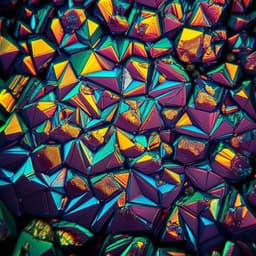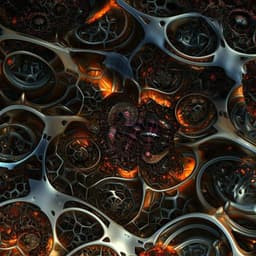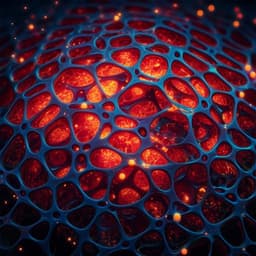
Engineering and Technology
Inverse design enables large-scale high-performance meta-optics reshaping virtual reality
Z. Li, R. Pestourie, et al.
Explore the future of virtual reality with a groundbreaking inverse-design framework for large-scale complex meta-optics, developed by Zhaoyi Li, Raphaël Pestourie, Joon-Suh Park, Yao-Wei Huang, Steven G. Johnson, and Federico Capasso. This innovative approach overcomes design challenges, resulting in aberration-corrected metalenses with impressive capabilities for polychromatic focusing.
~3 min • Beginner • English
Introduction
The study addresses the challenge of designing large-scale, complex meta-optics where conventional forward design (independent phase shifters per meta-atom) becomes impractical, especially for multiple functions across wavelengths, polarizations, and incidence angles and for large apertures. Inverse design, which optimizes geometries from target functions, promises to overcome these limitations but has been limited by computational costs of brute-force full-wave solvers and difficulty incorporating fabrication constraints. The authors’ goal is to create a computationally tractable inverse-design framework for aperiodic, three-dimensional, centimeter-scale meta-optics with complex, polarization-insensitive and polychromatic performance, and to validate it experimentally, including in a VR system.
Literature Review
Prior work established metasurfaces for diverse applications (imaging, displays, spectroscopy) and achieved achromatic metalenses, but forward phase-design methods are limited in multi-objective, large-aperture regimes due to phase–amplitude coupling and lack of feedback/optimality guarantees. Inverse design techniques in photonics include topology optimization, machine learning surrogates/generative models, and end-to-end co-optimization, with successes in on-chip photonics and smaller metasurfaces. However, aperiodic, fully 3D inverse-designed metasurfaces have been limited to ≲100 µm scale in the visible due to multiscale computational challenges. Incorporating fabrication constraints typically requires additional optimization constraints. The present work advances a surrogate-accelerated inverse design that scales to cm apertures while naturally embedding fabrication constraints.
Methodology
Objective: Maximize focal intensity at a target point for single or multiple wavelengths; for polychromatic design, optimize a differentiable approximation of the min intensity across a discrete wavelength set to achieve simultaneous focusing.
Forward solver: A 3D fast approximate solver computes fields at the focus by convolving locally predicted equivalent magnetic current sources above each meta-atom with a dyadic Green’s function. Local fields are predicted using a local periodic approximation and a surrogate model trained on rigorous coupled-wave analysis (RCWA) simulations of a meta-atom library. The surrogate uses Chebyshev interpolation with regression smoothing to rapidly predict local fields and their parameter derivatives, achieving orders-of-magnitude speedup over direct RCWA. The Green’s function is analytical in free space and reused across iterations. Cylindrical symmetry is imposed on design parameters to accelerate computation while retaining Cartesian tiling of subwavelength meta-atoms.
Adjoint gradients and optimization: Gradients of the objective with respect to all geometry parameters are computed via an adjoint method using a single backward simulation with an equivalent source constructed from the forward field and the surrogate’s sensitivities. Optimization uses a conservative convex separable approximation (CCSA) algorithm with multi-start initialization to navigate high-dimensional design spaces (≈10^10 degrees of freedom). Phase-matching initializations are infeasible for large apertures and multiwavelength targets due to insufficient single-layer group delay; thus, random initial designs are used.
Meta-atom and polarization: Anisotropic TiO2 nanofins on fused silica (height 600 nm, square lattice period 400 nm) support partial circular polarization conversion (LCP↔RCP) described by a Jones matrix, enabling polarization-insensitive focusing by symmetry for arbitrary incident polarization states.
Simulation details: RCWA generates the meta-atom library for 480–680 nm with opposite-handed circular polarization output channels for training the surrogate and computing local fields/sensitivities.
Fabrication: On glass wafers, spin-coat HMDS, 600-nm-thick ZEP-520A e-beam resist, and conductive polymer (ESPACER 300). Pattern via EBL (Elionix ELS-F125 for 2-mm lenses; HS-50 for 1-cm lens). Remove conductive layer, develop in o-xylene. Deposit conformal TiO2 by low-temperature ALD (Cambridge Nanotech Savannah) to fill features and overcoat resist. Remove overcoat by reactive ion etch (Oxford Plasma Pro 100 Cobra 300; CHF, O2, Ar) to expose resist, then strip resist in Remover PG at 85 °C for 24 h, leaving TiO2 nanostructures.
Experimental characterization: Measure axial and focal-plane intensity maps (XZ and XY), focal shifts, Strehl ratios, FWHM vs Airy predictions, and absolute focusing efficiency (power in focal spot/incident power) vs polarization angle. Imaging tests use USAF targets and a VR setup with a laser-illuminated micro-LCD (≈8 µm pixel) and a meta-eyepiece.
Key Findings
- Inverse-design framework: Achieves large-scale, aperiodic, 3D metasurface optimization with surrogate-accelerated forward simulation and adjoint gradients, compatible with fabrication constraints. Computationally tractable on a desktop (hours, single-core CPU), with reuse of analytical Green’s functions and Chebyshev surrogates that are ~10^6× faster than direct RCWA for local response prediction.
- 2-mm-diameter RGB-achromatic, polarization-insensitive metalens (NA = 0.7): Achromatic focusing at 488/532/658 nm with measured maximum axial focal shift ≈1.5 µm (~0.15% of focal length). Diffraction-limited performance with Strehl ratios ~0.97 (488 nm), 0.96 (532 nm), 0.94 (658 nm). Absolute focusing efficiency ~15% at RGB, independent of incident polarization angle. Imaging of USAF group 7 elements resolved (minimum feature 2.2 µm). Nanofin parameters: height 600 nm; period 400 nm; anisotropic rectangular cross-section aligned to cell axes.
- 2-mm-diameter six-wavelength polychromatic metalens (NA = 0.3): Design wavelengths 490, 520, 540, 570, 610, 650 nm. Measured XZ intensity maps agree with simulation; maximum focal shift ≈500 nm (<0.02% of focal length). Measured FWHM near Airy predictions; focusing efficiency ~8%. A similar NA = 0.7 six-wavelength device characterized in supplementary information.
- 1-cm-diameter RGB-achromatic metalens (NA = 0.3): Demonstrated on a 2-inch wafer using high-current EBL with ~10 nm structural resolution. Measured maximum focal shift among RGB ≈4.5 µm (~0.03% of focal length). Measured focusing efficiency ~15% versus simulated ~24% (differences attributed to fabrication errors such as field stitching). High-quality imaging of USAF group 7. Some focal-spot distortion due to non-uniform illumination across the cm-scale aperture.
- VR demonstration: A meta-eyepiece (cm-scale RGB-achromatic lens) with a laser back-illuminated micro-LCD (≈8 µm pixel) forms a near-eye display. Binary and grayscale images demonstrated in red, green, and blue; individual pixels are resolved. Dynamic video (running cat) displayed at 60 Hz. Color mixing verified by superimposing RGB channels to form full-color scenes.
- Benchmarking versus forward design (simulations in SI): Forward designs yield lower and non-uniform RGB efficiencies and struggle with multiple objectives/constraints; inverse design achieves higher (~24% simulated) and uniform efficiencies and can mitigate ghost foci/halo via tailored objective functions.
- Scale and impact: Devices up to ~10^9 meta-atoms and ~10^10 DOF optimized, surpassing prior inverse-designed visible metasurfaces limited to ~100 µm apertures.
Discussion
The results validate that inverse design with a fast surrogate-based forward solver and adjoint gradients can overcome multiscale challenges to produce centimeter-scale, polarization-insensitive, polychromatic metalenses with high NA and diffraction-limited performance. Compared to forward phase-matching, the inverse-designed devices exhibit more uniform, higher efficiencies across wavelengths and polarizations and can explicitly control trade-offs and suppress undesired artifacts through objective functions. The VR demonstrations highlight immediate relevance: a compact, aberration-corrected meta-eyepiece can resolve micro-display pixels and support video-rate operation. Remaining efficiency gaps arise from both fabrication imperfections and single-layer meta-atom limitations. The framework is extensible to other VR/AR components (e.g., combiners) and complex metasystems. Future computational and device-level advances (e.g., richer freeform/multilayer meta-atoms, improved surrogates via physics-informed/active-learning neural networks, supercell local models, domain decomposition, or axisymmetric acceleration) can further enhance performance and scalability, enabling correction of higher-order aberrations and hybrid meta-refractive designs.
Conclusion
A general, fabrication-aware inverse-design framework for large-scale 3D meta-optics was introduced and experimentally validated through 2-mm RGB-achromatic and six-wavelength metalenses (including NA = 0.7) and a 1-cm RGB-achromatic metalens, enabling a practical meta-eyepiece for VR with pixel-resolving, color-capable, video-rate imaging. The approach scales inverse design to unprecedented device sizes and complexities, offering a path to compact, high-performance optical systems. Future work should increase focusing efficiency via advanced freeform/multilayer meta-atoms, correct higher-order aberrations, and further accelerate/accuratize surrogates (e.g., physics-enhanced neural networks and supercell models), including multi-surface and hybrid meta-refractive architectures for VR/AR.
Limitations
Measured focusing efficiency remains modest (~15% at RGB) and below simulations (~24%) due to fabrication imperfections (e.g., e-beam field stitching) and single-layer meta-atom constraints. Some focal-spot distortions arise from non-uniform illumination across large apertures not modeled in design. The local periodic approximation is most accurate for moderate NA and slowly varying meta-atom parameters; rapidly varying regions may deviate. The Chebyshev surrogate scales poorly with increasing parameter dimensionality, requiring larger training datasets; more complex meta-atoms and supercell models will demand improved surrogate strategies. Current designs correct aberrations primarily under normal incidence; higher-order and off-axis aberrations (e.g., coma, field curvature) require further optimization. Reported detailed performance for some variants (e.g., NA = 0.7 six-wavelength device) is deferred to supplementary material.
Related Publications
Explore these studies to deepen your understanding of the subject.







